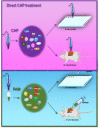Current Status and Future Trends of Cold Atmospheric Plasma as an Oncotherapy
- PMID: 37641880
- PMCID: PMC10468422
- DOI: 10.4062/biomolther.2023.027
Current Status and Future Trends of Cold Atmospheric Plasma as an Oncotherapy
Abstract
Cold atmospheric plasma (CAP), a redox modulation tool, is capable of inhibiting a wide spectrum of cancers and has thus been proposed as an emerging onco-therapy. However, with incremental successes consecutively reported on the anticancer efficacy of CAP, no consensus has been made on the types of tumours sensitive to CAP due to the different intrinsic characteristics of the cells and the heterogeneous design of CAP devices and their parameter configurations. These factors have substantially hindered the clinical use of CAP as an oncotherapy. It is thus imperative to clarify the tumour types responsive to CAP, the experimental models available for CAP-associated investigations, CAP administration strategies and the mechanisms by which CAP exerts its anticancer effects with the aim of identifying important yet less studied areas to accelerate the process of translating CAP into clinical use and fostering the field of plasma oncology.
Keywords: Cancer; Cold atmospheric plasma; Device; Research status; Trends.
Conflict of interest statement
The authors declare no competing interest.
Figures




Similar articles
-
The Emerging Role of Gas Plasma in Oncotherapy.Trends Biotechnol. 2018 Nov;36(11):1183-1198. doi: 10.1016/j.tibtech.2018.06.010. Epub 2018 Jul 20. Trends Biotechnol. 2018. PMID: 30033340 Review.
-
Recent advances in cold atmospheric plasma (CAP) for breast cancer therapy.Cell Biol Int. 2023 Feb;47(2):327-340. doi: 10.1002/cbin.11939. Epub 2022 Nov 7. Cell Biol Int. 2023. PMID: 36342241 Review.
-
Clinical and Biological Principles of Cold Atmospheric Plasma Application in Skin Cancer.Adv Ther. 2016 Jun;33(6):894-909. doi: 10.1007/s12325-016-0338-1. Epub 2016 May 3. Adv Ther. 2016. PMID: 27142848 Free PMC article. Review.
-
Cold Atmospheric Pressure Plasma (CAP) as a New Tool for the Management of Vulva Cancer and Vulvar Premalignant Lesions in Gynaecological Oncology.Int J Mol Sci. 2020 Oct 27;21(21):7988. doi: 10.3390/ijms21217988. Int J Mol Sci. 2020. PMID: 33121141 Free PMC article. Review.
-
Therapeutic Effects of Cold Atmospheric Plasma on Solid Tumor.Front Med (Lausanne). 2022 May 13;9:884887. doi: 10.3389/fmed.2022.884887. eCollection 2022. Front Med (Lausanne). 2022. PMID: 35646968 Free PMC article. Review.
Cited by
-
[Mechanism of cold atmospheric plasma in treatment of chronic skin ulcer].Zhongguo Xiu Fu Chong Jian Wai Ke Za Zhi. 2024 Oct 15;38(10):1283-1288. doi: 10.7507/1002-1892.202404027. Zhongguo Xiu Fu Chong Jian Wai Ke Za Zhi. 2024. PMID: 39433505 Free PMC article. Review. Chinese.
-
Cancer metastasis: molecular mechanisms and therapeutic interventions.Mol Biomed. 2025 Apr 7;6(1):20. doi: 10.1186/s43556-025-00261-y. Mol Biomed. 2025. PMID: 40192949 Free PMC article. Review.
-
Combined Application of Cold Physical Plasma and Chemotherapeutics against Chondrosarcoma Cells.Int J Mol Sci. 2024 Jun 25;25(13):6955. doi: 10.3390/ijms25136955. Int J Mol Sci. 2024. PMID: 39000064 Free PMC article.
References
-
- Adhikari M., Kaushik N., Ghimire B., Adhikari B., Baboota S., Al-Khedhairy A. A., Wahab R., Lee S.-J., Kaushik N. K., Choi E. H. Cold atmospheric plasma and silymarin nanoemulsion synergistically inhibits human melanoma tumorigenesis via targeting HGF/c-MET downstream pathway. Cell Commun. Signal. 2019;17:52. doi: 10.1186/s12964-019-0360-4.cc23855879af44aca17d6c21a0ed63d9 - DOI - PMC - PubMed
-
- Aggelopoulos C. A., Christodoulou A.-M., Tachliabouri M., Meropoulis S., Christopoulou M.-E., Karalis T. T., Chatzopoulos A., Skandalis S. S. Cold atmospheric plasma attenuates breast cancer cell growth through regulation of cell microenvironment effectors. Front. Oncol. 2022;11:826865. doi: 10.3389/fonc.2021.826865.53c8187a5df94fdbb3cba5b1ff468a89 - DOI - PMC - PubMed
Publication types
LinkOut - more resources
Full Text Sources
Miscellaneous

